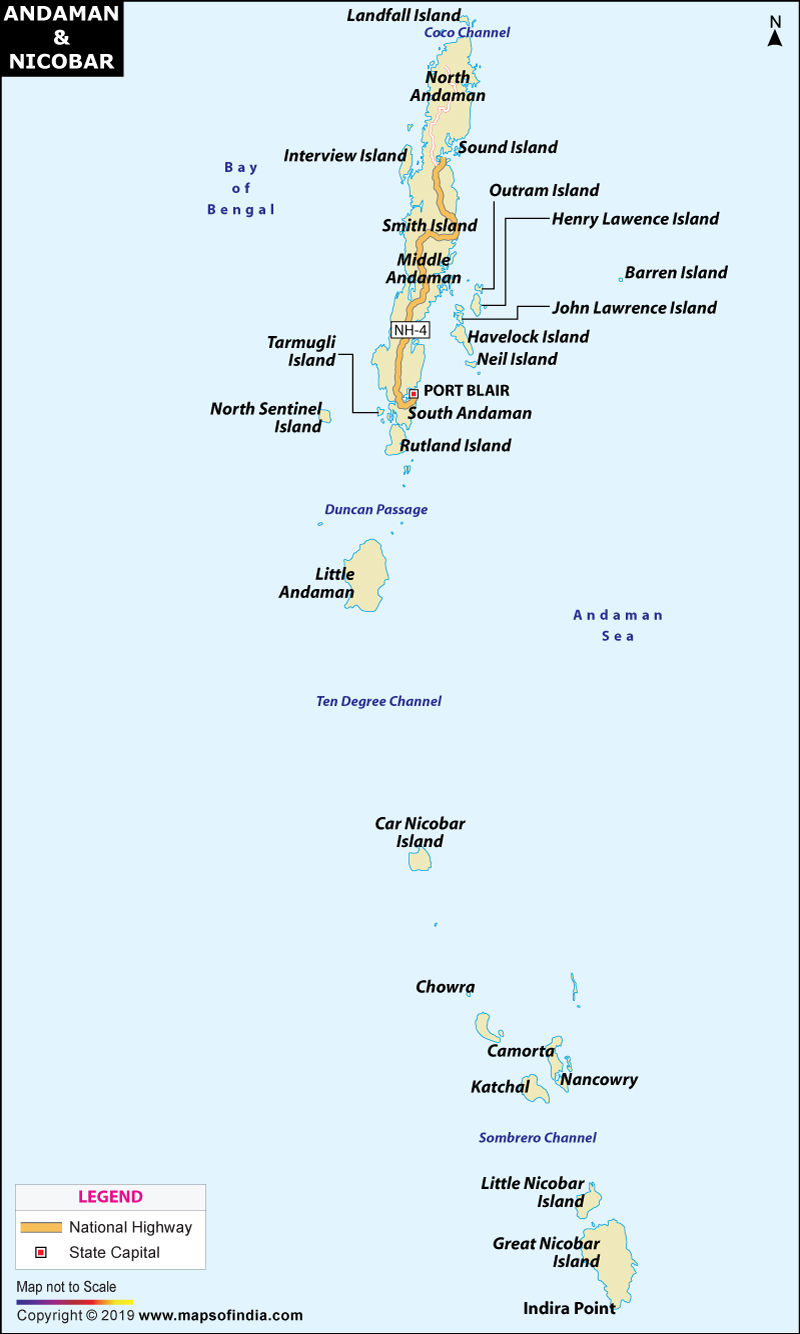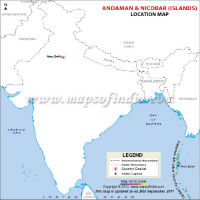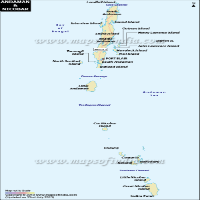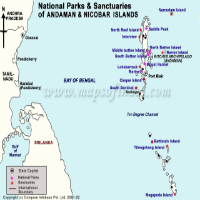About Andaman and Nicobar Islands
Andaman and Nicobar Islands is a union territory of India and is located in the Indian Ocean.
Archaeological evidences prove that the first settlement in Andaman and Nicobar Islands dates back to the middle of the Paleolithic age.
- The Andamanese are said to be the first inhabitants of Andaman Islands.
- Till 1850, the Andamanese lived in complete isolation; it was after 1850 that they came in contact with the outside world.
- Nicobarese were the aborigines of the Nicobar Islands; they lived in the Nicobar group of islands with Shompens.
In the 18th century, after the Britishers came to India, the island emerged in the global scenario. But, during the British period, they became infamous as the 'Kalapani', where people convicted of any offense against the British government were kept. The Britishers transformed the exotic island into a 'penal colony', where culprits charged with life sentences were imprisoned.
- Andaman Islands:
- Long Island
- Neil Island
- Rangat
- Diglipur
- Mayabunder
- Little Andaman Islands, etc.
- Nicobar Islands:
- Katchal
- Car Nicobar
- Great Nicobar, etc.
- Port Blair:
- Gandhi Park,
- Mahatma Gandhi National Park,
- Chidiya Tapu,
- Sippighat Farm,
- Collinpur,
- Mini Zoo,
- Mount Harriet,
- Madhuban, etc.
Andaman and Nicobar Islands - Facts
The Andaman and Nicobar Islands, home to a number of aboriginal tribes, lie in the Bay of Bengal, approximately 1,220 km southeast to the coast of West Bengal and 1,190 km east of Chennai. The main islands in the Andamans are Land Fall Island, Middle Andaman, South Andaman, Port Blair and Little Andaman. Nicobar, lying to the south, comprises Car Nicobar, Great Nicobar, Chowra, Teresa, Nancowrie, Katchal and Little Nicobar. The two groups of islands, Andaman and Nicobar, are separated by a deep ten degree channel. 12 of the islands, particularly Car Nicobar in the north, are inhabited, while Great Nicobar, the largest and southernmost island in the group, is virtually unpopulated. The capital of this union territory is Port Blair, on the Andaman Islands.
Andaman and Nicobar islands are popularly known as the Emerald Isles. The erstwhile 'Kalapani' or the Cellular Jail, now a museum, is among the most popular tourist destinations in India.
| Facts on Andaman and Nicobar Islands | |
|---|---|
| Official Website | www.andamans.gov.in |
| Date of Formation (Declared a Union Territory) | November 1, 1956 |
| Area | 8,249 sq km |
| Density | 46/Km2 |
| Total Population (2011) | 3,80,581 |
| Males Population (2011) | 2,02,871 |
| Females Population (2011) | 1,77,710 |
| No. of District | 3 |
| Capital | Port Blair |
| Rivers | Hooghly, Kalpong |
| Forests & National Park | Little Nicobar WS, Landfall Island WS |
| Languages | Bengali, Hindi, Tamil, Malayalam, Nicobarese, Telugu |
| State Animal | Dugong |
| State Bird | Wood Pigeon |
| State Tree | Andaman Padauk |
| Net State Domestic Product (2011) | 76,883 |
| Literacy Rate (2011) | 77.65% |
| Females per 1,000 males | 878 |
| Assembly constituency | 0 |
| Parliamentary constituency | Andaman and Nicobar Islands |
History
The existence of these islands was first reported in the 9th century by Arab merchants, who sailed past them, on their way to the straits of Sumatra. The first Western visitor was Marco Polo, who called it `the land of the head - hunters'. The islands were annexed by the Marathas in the late 17th century. In the early 18th century, they were the base of Maratha admiral Kanhoji Angre, whose navy frequently captured British, Dutch and Portugese merchant ships. Angre remained undefeated by the combined British / Portuguese naval task force, right up to his death in 1729. The Nicobar Islands were annexed by Britain in 1869 and were joined with the Andaman Islands to form a single administrative unit in 1872. Japanese forces occupied the islands from 1942 until the end of World War in 1945, and control of the territory was transferred to India when it gained independence from Britain in 1947. More Details...
Geography
Geographically located at 11° 41' N and 92° 46' E, these islands are a part of the Bay of Bengal. Two groups of islands, the Andaman and the Nicobar islands lie towards the Southeastern part of the Indian mainland. The groups of islets, islands and rocks sprawl over a total area of 8,249 sq. km. The capital city of this union territory is Port Blair, which is even the largest city of the place. The STD (Standard Trunk Dialing) code of these islands is 03192. More Details...
Climatic conditions of Andaman & Nicobar Islands
Being surrounded by sea, the islands of Andaman and Nicobar experience a moderate temperature throughout the year. With a humidity of about 80%, sea breeze helps the temperature to range in between 23° C and 31° C. The inhabitants of the islands get wet monsoon in different phases in a year. Monsoon brought by the southwest wind sets in during mid-May and continues till early October. Then after a gap of about one and a half month, again monsoon from the northeast starts in the month of November and stretches till December. More Details...
Demographics
As per the Census 2011, these popular islands of the country have a population of 3,80,581 with a population density of 46 people per sq. km. The sex ratio of the islands is 878 females per 1,000 males.
| Demographics | |
|---|---|
| Location | Within the Bay of Bengal 193 km away from Cape Negrais in Myanmar, 1255 km from Kolkata, 1190 km from Chennai |
| Latitude | 6° and 14° North |
| Longitude | Between 92° and 94° East |
| Area | 8,249 Square Kilometers |
| Climate | Tropical throughout the year. There is no extreme climate except rains and tropical storms in late summer often cause heavy damage |
| Max Temperature | 31°C |
| Min Temperature | 23°C |
| Humidity | 70% - 90% |
| Rainy Season | May - mid September November - mid December |
| Average Annual Rainfall | 3,180.0 mm |
| Capital | Port Blair |
| Population | 3,80,581 (2011 Census).Of the total 572 islands, Only 38 islands are inhabited by humans |
| Languages | Bengali, Hindi, Tamil, Malayalam, Nicobarese, Telugu |
| Religion | Hinduism, Christianity, Islam, Others |
| Best Time to Visit | October to May |
| Clothing | Light Cottons throughout the year |
Languages
The main language of these islands is Nicobarese. However, official languages like Hindi, Bengali, Tamil, Telugu and English are even being widely used here.
Government and Politics
The government and politics of Andaman and Nicobar Islands operate in a way that is slightly different from the governance of most states and union territories of India. The first notable thing about the government and politics of the islands is the lack of a legislature. The lieutenant governor is himself the executive head in the government of Andaman and Nicobar. The executive wing runs under his supervision, under direct monitoring by the heads of the various departments. The state judiciary falls under the supervision of the Kolkata High Court. The lieutenant governor is the most important figure in the government and politics in Andaman and Nicobar Islands. In the absence of a formal legislative council, the lieutenant governor looks after the entire legislative structure of the state. The various departments work under his supervision. The government departments of the state operate on both directorate and the secretariat levels and take care of the state executive. The presence of many central government organisations also helps in enhancing the administrative as well as governance profile of Andaman and Nicobar. More Details...
Economy
The Andamans have immense potential but they have not been utilised till now. The development has been insignificant but the population has increased alarmingly. Luxurious rainforests make the Andamans a 'gold mine' of timber. Tropical fruits are found on the hilly parts of the islands in abundance. The potential for fishery here, offers opportunities for industrial development. Paddy is the main cash crop here, while coconut and areca nut are the main cash crops of the Nicobar islands. Field crops namely pulses, oilseeds and vegetables and spices like pepper, cloves, nutmeg and cinnamon are also cultivated. Rubber, red oil, palm and cashew are grown on a limited scale on these islands. The major industries in the region include PVC conduit pipes and fittings, paints and varnishes, fiber glass, soft drinks and beverages, and steel furniture.
Regular passenger ship services viz. MV Harshavardhana, MV Akbar and MV Nicobar are plying between Port Blair and Chennai, Kolkata, Vizag . More Details...
Infrastructure
Infrastructure of Andaman and Nicobar Islands might not be state of art in comparison to other states and union territories but still it has got the required infrastructure to support the existing industries. The main elements of infrastructure of any place are its industries, transport, communication, etc. The main component of infrastructure at Andaman and Nicobar Islands is its transport system. In this regard, it can be said that the transport system of the islands group has improved a lot and is moving towards betterment. The Motor Transport Department of Andaman and Nicobar Islands have extended their services to ten other islands apart from Port Blair while the State Transport Services is plying many buses on several routes. More Details...
Education
Like other states in India, the Andaman and Nicobar Islands also has an education system which offers free and compulsory education to the children below the age of 14 years. The higher secondary education here is affiliated to the Central Board of Secondary Education (CBSE). Colleges are generally affiliated to the Pondicherry University and there are some polytechnics affiliated to New Delhi. The place lacks colleges and institutions where students can get professional degrees in the field of medicine, engineering and law. Steps are taken by the authorities to get such institutions here.
Society and Culture
The Andaman & Nicobar Islands are characterised by two distinct native cultures. One is of the Negrito population in the Andamans and the other is of the Autochthones, i.e. the Mongoloid Nicobarese and Shompen. Both during pre and post British periods and even after Independence, these two cultures have maintained their distinct identities. The original native group in the Andamans is the Onges, who live in Little Andaman. Onges, like other Andamanese tribes, are of Negrito origin. They practice food-gathering, hunting, honey-collecting and fishing, and are the only tribe on the islands, who freely accept contact with the outside world. In the Nicobars, the only aboriginals are the Shompens, who are averse to any contact with the outside world.
The Nicobarese, the largest group, seem to be of mixed Burmese, Malay, Mon and Shan origin. They are a friendly and cheerful lot, who do not accept money and prefer the barter system. Communing with the dead is one of the many intriguing rituals practiced in Nicobar.
The special festive celebrations of particular groups include Durgapuja for the Bengalis, Panguni Uthiram for the Tamils, Pongal for the Telugus and Onam for the Malayalis. The local born of the Andamans, who are divided into Hindus, Muslims and Christians, celebrate the festivals of all the three religions. Some of their main festivals are Shivratri, Janmashtami, Holi, Diwali, Ramanavami, Eid, Christmas, Good Friday etc. All three religious groups among the locals participate in one another's festivals.
Thus the people of the Andaman and Nicobar Islands, irrespective of the regions that they originally come from or the religion they practice or the language or dialect they speak have many common cultural traits. A remarkable feature of Andaman and Nicobar society is the amicable co-existence of the people belonging to the different religions. Communal violence is unheard of here. There is amicable participation of all in religious festivals and the incidence of inter-religious marriages is increasing. More Details...
Food
This island is a fusion of various cuisines from different parts of India. Sea food delicacy is the specialty of Andaman and Nicobar island. Some of the must try dishes are Tandoori Fish, Rice, Roti, Naan, Curried Prawns, Grilled Lobsters, Barbeques, and various other Indian Cuisines.
Tourism
Isolated from the mainland of India, the place is a group of floating emerald islands and rocks. Andaman & Nicobar Islands are famous for housing exotic sea beaches bordered by coconut-palm trees and the transparent blue water, which is home to underwater corals and other marine life. The unpolluted air along with the mangrove-lined creeks and the rarest species of plant and animal life will make you fall in love with nature.
Major tourist attractions of Andaman & Nicobar Islands
The group of 572 islands of Andaman and Nicobar can be regarded as a naturalist's heaven for its clean environment and crystal clear water bodies. The different hilly areas covered by lush green rain forests and sun kissed sea beaches are some of the major tourist attractions of the place. These islands are even known for adventurous activities like scuba diving, trekking, snorkeling, camping and various other water sports. Following are some of the famous tourist places, which one need not miss during a trip to the Andaman and Nicobar islands of India:
- Baratang
- Barren Island
- Cellular Jail
- Havelock Island
- Corbyn's Cove Beach
- Radhnagar Beach
- National Memorial Museum
- Fisheries Museum
- Ross Island
- Chidiya Tapu
- Mount Harriet
- Mahatma Gandhi Marine National Park
- Gandhi Park
- Neil Island
- Katchal
Some of the famous tourist spots in the Andaman and Nicobar Islands include National Memorial, Marine Museum, Naval Marine Museum, Smrithika Museum, Haddo Zoological Garden, Corbyn's Cove, and other beaches, and Humphrey Gunj Memorial. Andaman Water Sports Complex at Port Blair, Chatam Saw Mill (largest in Asia), Chidiya Tapu, Marine Museum, the island of red Skin, and Havelock are the other attractions. Corbyn's Cove, Wandoor beach, Sippighat water sports complex, Cinque island, and Jolly Buoy Island are some adventurous spots on the island. More Details...
Transport
The islands of Andaman and Nicobar are well connected to other parts of the country as well as the foreign places by air and waterways. The islands have even got bus and other modes of road transport for travelling internally. Being islands, the place is not connected to the other parts of the country by railways though. The Veer Savarkar Airport of Port Blair connects the islands to the other parts of the country by airways. Waterways serve the Andaman and Nicobar islands in both ways, external as well as internal transport. Port Blair, the intermediate port serves as the main port of these islands. Apart from the buses run by the state transport and private transport companies, residents of these islands are very fond of private taxis and auto-rickshaws. They even use motorcycles and bicycles for an easy and fast travel.
WBST171114
EBAKB181114
Last Updated on: August 28, 2019



